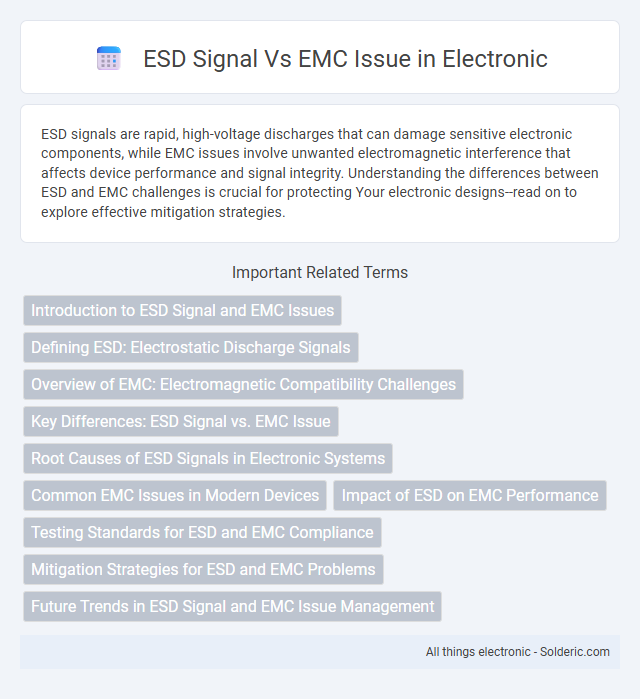ESD signals are rapid, high-voltage discharges that can damage sensitive electronic components, while EMC issues involve unwanted electromagnetic interference that affects device performance and signal integrity. Understanding the differences between ESD and EMC challenges is crucial for protecting Your electronic designs--read on to explore effective mitigation strategies.
Comparison Table
| Aspect | ESD Signal | EMC Issue |
|---|---|---|
| Definition | Electrostatic Discharge, sudden flow of static electricity | Electromagnetic Compatibility problems, interference affecting device functionality |
| Cause | Static charge build-up and abrupt discharge | Electromagnetic interference (EMI) from external or internal sources |
| Effect | Potential damage or malfunction of electronic components | Signal distortion, data errors, device malfunction |
| Frequency Range | Typically high-frequency transient pulses (MHz to GHz) | Broad frequency range (kHz to GHz) depending on source |
| Testing Standards | IEC 61000-4-2 | IEC 61000 series (e.g., 4-3, 4-4, 4-6) |
| Mitigation | ESD protection devices, grounding, shielding, PCB layout | Shielding, filtering, proper grounding, layout optimization |
| Typical Sources | Human body, plastic materials, footwear on floor | Motors, switching power supplies, radio transmitters |
Introduction to ESD Signal and EMC Issues
ESD (Electrostatic Discharge) signals are sudden and rapid transfer of electrostatic charge that can cause immediate damage or degradation to sensitive electronic components. EMC (Electromagnetic Compatibility) issues arise when electronic devices emit or are susceptible to electromagnetic interference (EMI), disrupting device performance and communication signals. Understanding the distinction between ESD signals, which are short-duration high-voltage pulses, and broader EMC issues, which involve continuous or intermittent electromagnetic emissions, is critical for designing robust electronic systems.
Defining ESD: Electrostatic Discharge Signals
Electrostatic Discharge (ESD) signals refer to sudden, brief bursts of static electricity that occur when two electrically charged objects come into contact or close proximity, causing a rapid transfer of charge. ESD signals typically involve high-voltage, low-current discharges that can induce transient disturbances in electronic circuits, leading to potential device damage or malfunction. Differentiating ESD signals from Electromagnetic Compatibility (EMC) issues is crucial, as EMC encompasses broader electromagnetic interference and susceptibility phenomena affecting system performance under normal operational conditions.
Overview of EMC: Electromagnetic Compatibility Challenges
Electromagnetic Compatibility (EMC) challenges arise from the need to ensure electronic devices operate without interfering with each other, maintaining signal integrity and compliance with regulatory standards. Electrostatic Discharge (ESD) events generate abrupt, high-voltage pulses that can disrupt normal device functioning or cause damage, representing a critical subset of EMC issues. Understanding and mitigating ESD signals is essential for preserving your system's electromagnetic compatibility and reliable performance.
Key Differences: ESD Signal vs. EMC Issue
ESD signals are abrupt, high-voltage discharges causing instantaneous disturbances, while EMC issues involve broader electromagnetic interference affecting device performance over varying frequencies. ESD primarily impacts device reliability through sudden spikes, whereas EMC concerns ongoing emissions and susceptibility within regulatory limits. Understanding these distinctions helps you implement targeted mitigation strategies for improved electronic system stability.
Root Causes of ESD Signals in Electronic Systems
ESD signals in electronic systems primarily originate from sudden electrostatic discharges caused by human contact, equipment interaction, or environmental factors like low humidity. These discharges generate high-frequency transients that can disrupt normal circuit operation and induce noise, complicating EMC compliance. Understanding your system's grounding, shielding, and component sensitivity is crucial for identifying and mitigating the root causes of ESD-related disturbances.
Common EMC Issues in Modern Devices
Common EMC issues in modern devices include electromagnetic interference (EMI) disrupting signal integrity and power fluctuations causing malfunctions. Electrostatic discharge (ESD) events can trigger latent faults or immediate failures in sensitive circuits, compromising device reliability. Protecting Your equipment with proper shielding and ESD mitigation techniques ensures consistent performance and compliance with EMC standards.
Impact of ESD on EMC Performance
Electrostatic discharge (ESD) significantly affects electromagnetic compatibility (EMC) performance by causing transient disturbances that disrupt normal device operation. ESD events generate high-frequency noise and voltage spikes, potentially leading to data corruption, system resets, or permanent damage in sensitive electronic components. Ensuring robust ESD protection enhances your system's resilience against EMC issues, improving overall device reliability and compliance with regulatory standards.
Testing Standards for ESD and EMC Compliance
Testing standards for ESD and EMC compliance include IEC 61000-4-2 for Electrostatic Discharge immunity and IEC 61000-4-3 for Radiated Electromagnetic Field immunity, ensuring devices withstand ESD strikes and electromagnetic interference. Your product must meet these standards to guarantee reliable performance and prevent malfunctions caused by ESD events or EMC disturbances. Compliance testing involves precise simulation of real-world electrical environments to analyze resilience against ESD pulses and EMI emissions.
Mitigation Strategies for ESD and EMC Problems
Mitigation strategies for ESD and EMC problems include implementing proper grounding techniques, using shielding materials, and incorporating filters to reduce noise and transient disturbances. Employing ESD protection components such as transient voltage suppressors (TVS) and electrostatic discharge protection diodes enhances device robustness against electrostatic events. Additionally, designing circuit layouts with controlled impedance and ensuring compliance with EMC standards minimizes electromagnetic interference and improves overall system reliability.
Future Trends in ESD Signal and EMC Issue Management
Future trends in ESD signal and EMC issue management emphasize advanced materials with enhanced conductive properties to prevent electrostatic discharge and electromagnetic interference. Integration of AI-driven predictive analytics and real-time monitoring systems is revolutionizing how your devices maintain signal integrity and comply with EMC standards. Emerging standards and miniaturized components necessitate proactive design strategies to mitigate risks and ensure robust, future-proof electronic performance.
ESD signal vs EMC issue Infographic

 solderic.com
solderic.com